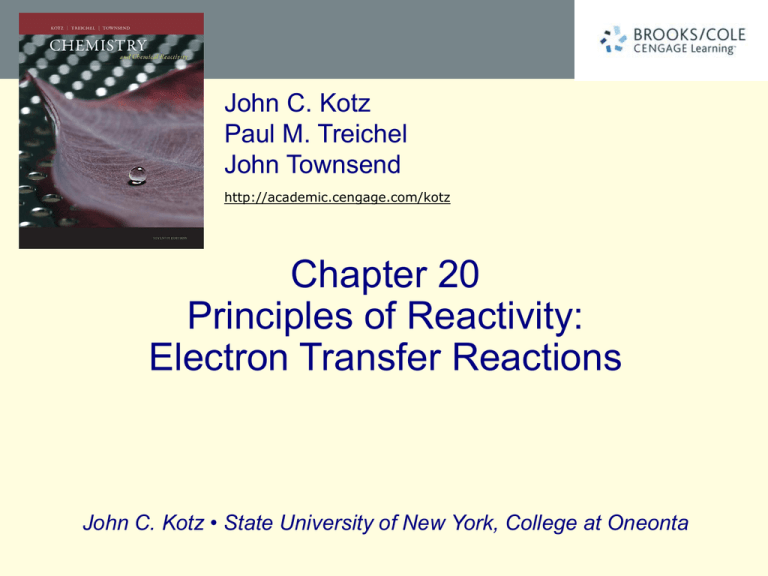ELECTROCHEMISTRY Chapter 21
advertisement

John C. Kotz Paul M. Treichel John Townsend http://academic.cengage.com/kotz Chapter 20 Principles of Reactivity: Electron Transfer Reactions John C. Kotz • State University of New York, College at Oneonta Important – Read Before Using Slides in Class Instructor: This PowerPoint presentation contains photos and figures from the text, as well as selected animations and videos. For animations and videos to run properly, we recommend that you run this PowerPoint presentation from the PowerLecture disc inserted in your computer. Also, for the mathematical symbols to display properly, you must install the supplied font called “Symb_chm,” supplied as a cross-platform TrueType font in the “Font_for_Lectures” folder in the "Media" folder on this disc. If you prefer to customize the presentation or run it without the PowerLecture disc inserted, the animations and videos will only run properly if you also copy the associated animation and video files for each chapter onto your computer. Follow these steps: 1. Go to the disc drive directory containing the PowerLecture disc, and then to the “Media” folder, and then to the “PowerPoint_Lectures” folder. 2. In the “PowerPoint_Lectures” folder, copy the entire chapter folder to your computer. Chapter folders are named “chapter1”, “chapter2”, etc. Each chapter folder contains the PowerPoint Lecture file as well as the animation and video files. For assistance with installing the fonts or copying the animations and video files, please visit our Technical Support at http://academic.cengage.com/support or call (800) 423-0563. Thank you. ELECTROCHEMISTRY Chapter 20 © 2009 Brooks/Cole - Cengage 3 TRANSFER REACTIONS Atom/Group transfer HCl + H2O f Cl- + H3O+ Electron transfer Cu(s) + 2 Ag+(aq) f Cu2+(aq) + 2 Ag(s) © 2009 Brooks/Cole - Cengage 4 5 Electron Transfer Reactions • Electron transfer reactions are oxidationreduction or redox reactions. • Redox reactions can result in the generation of an electric current or be caused by imposing an electric current. • Therefore, this field of chemistry is often called ELECTROCHEMISTRY. © 2009 Brooks/Cole - Cengage Review of Terminology for Redox Reactions • OXIDATION—loss of electron(s) by a species; increase in oxidation number. • REDUCTION—gain of electron(s); decrease in oxidation number. • OXIDIZING AGENT—electron acceptor; species is reduced. • REDUCING AGENT—electron donor; species is oxidized. © 2009 Brooks/Cole - Cengage 6 7 OXIDATION-REDUCTION REACTIONS Direct Redox Reaction Oxidizing and reducing agents in direct contact. Cu(s) + 2 Ag+(aq) f Cu2+(aq) + 2 Ag(s) PLAY MOVIE © 2009 Brooks/Cole - Cengage 8 OXIDATION-REDUCTION REACTIONS Indirect Redox Reaction A battery functions by transferring electrons through an external wire from the reducing agent to the oxidizing agent. PLAY MOVIE © 2009 Brooks/Cole - Cengage Why Study Electrochemistry? • Batteries • Corrosion • Industrial production of chemicals such as Cl2, NaOH, F2 and Al • Biological redox reactions © 2009 Brooks/Cole - Cengage The heme group 9 10 Electrochemical Cells • An apparatus that allows a redox reaction to occur by transferring electrons through an external connector. • Product favored reaction f voltaic or galvanic cell f chemical change produces electric current • Reactant favored reaction f electrolytic cell f electric current used to cause chemical change. © 2009 Brooks/Cole - Cengage Batteries are voltaic cells Electrochemistry Alessandro Volta, 1745-1827, Italian scientist and inventor. Luigi Galvani, 1737-1798, Italian scientist and inventor. © 2009 Brooks/Cole - Cengage 11 Balancing Equations for Redox Reactions Some redox reactions have equations that must be balanced by special techniques PLAY MOVIE MnO4- + 5 Fe2+ + 8 H+ f Mn2+ + 5 Fe3+ + 4 H2O Mn = +7 © 2009 Brooks/Cole - Cengage Fe = +2 Mn = +2 Fe = +3 12 Balancing Equations Cu + Ag+ © 2009 Brooks/Cole - Cengage --give--> Cu2+ + Ag 13 Balancing Equations Step 1: Divide the reaction into half-reactions, one for oxidation and the other for reduction. Ox Cu f Cu2+ Red Ag+ f Ag Step 2: Balance each for mass. Already done in this case. Step 3: Balance each half-reaction for charge by adding electrons. Ox Cu f Cu2+ + 2eRed Ag+ + e- f Ag © 2009 Brooks/Cole - Cengage 14 Balancing Equations Step 4: Multiply each half-reaction by a factor so that the reducing agent supplies as many electrons as the oxidizing agent requires. Reducing agent Cu f Cu2+ + 2eOxidizing agent 2 Ag+ + 2 e- f 2 Ag Step 5: Add half-reactions to give the overall equation. Cu + 2 Ag+ f Cu2+ + 2Ag The equation is now balanced for both charge and mass. © 2009 Brooks/Cole - Cengage 15 Reduction of VO2+ with Zn © 2009 Brooks/Cole - Cengage 16 Balancing Equations Balance the following in acid solution— VO2+ + Zn f VO2+ + Zn2+ Step 1: Write the half-reactions Ox Zn f Zn2+ Red VO2+ f VO2+ Step 2: Balance each half-reaction for mass. Ox Zn f Zn2+ Red 2 H+ + VO2+ f VO2+ + H2O Add H2O on O-deficient side and add H+ on other side for H-balance. © 2009 Brooks/Cole - Cengage 17 Balancing Equations Step 3: Ox Red Step 4: Ox Red 2e- Balance half-reactions for charge. Zn f Zn2+ + 2ee- + 2 H+ + VO2+ f VO2+ + H2O Multiply by an appropriate factor. Zn f Zn2+ + 2e+ 4 H+ + 2 VO2+ f 2 VO2+ + 2 H2O Step 5: Add balanced half-reactions Zn + 4 H+ + 2 VO2+ f Zn2+ + 2 VO2+ + 2 H2O © 2009 Brooks/Cole - Cengage 18 19 Tips on Balancing Equations • Never add O2, O atoms, or O2- to balance oxygen. • Never add H2 or H atoms to balance hydrogen. • Be sure to write the correct charges on all the ions. • Check your work at the end to make sure mass and charge are balanced. • PRACTICE! © 2009 Brooks/Cole - Cengage CHEMICAL CHANGE f ELECTRIC CURRENT With time, Cu plates out onto Zn metal strip, and Zn strip “disappears.” Electrons are transferred from Zn to Cu2+, but there is no useful electric current. Oxidation: Zn(s) f Zn2+(aq) + 2eReduction: Cu2+(aq) + 2e- f Cu(s) -------------------------------------------------------Cu2+(aq) + Zn(s) f Zn2+(aq) + Cu(s) © 2009 Brooks/Cole - Cengage 20 CHEMICAL CHANGE f ELECTRIC CURRENT •To obtain a useful current, we separate the oxidizing and reducing agents so that electron transfer occurs thru an external wire. This is accomplished in a GALVANIC or VOLTAIC cell. A group of such cells is called a battery. © 2009 Brooks/Cole - Cengage 21 22 Zn f Zn2+ + 2e- Cu2+ + 2e- f Cu Oxidation Anode Negative Reduction Cathode Positive rAnions Cationsf • Electrons travel thru external wire. • Salt bridge allows anions and cations to move between electrode compartments. © 2009 Brooks/Cole - Cengage The © 2009 Brooks/Cole - Cengage Cu|Cu2+ and Ag|Ag+ Cell 23 24 Electrons move from anode to cathode in the wire. Anions & cations move thru the salt bridge. Electrochemical Cell PLAY MOVIE © 2009 Brooks/Cole - Cengage 25 Terms Used for Voltaic Cells See Figure 20.6 © 2009 Brooks/Cole - Cengage 26 The Voltaic Pile Drawing done by Volta to show the arrangement of silver and zinc disks to generate an electric current. What voltage does a cell generate? © 2009 Brooks/Cole - Cengage CELL POTENTIAL, E 27 1.10 V Zn and Zn2+, anode Cu and Cu2+, cathode 1.0 M 1.0 M • Electrons are “driven” from anode to cathode by an electromotive force or emf. • For Zn/Cu cell, this is indicated by a voltage of 1.10 V at 25 ˚C and when [Zn2+] and [Cu2+] = 1.0 M. © 2009 Brooks/Cole - Cengage 28 CELL POTENTIAL, E • For Zn/Cu cell, potential is +1.10 V at 25 ˚C and when [Zn2+] and [Cu2+] = 1.0 M. • This is the STANDARD CELL POTENTIAL, Eo • —a quantitative measure of the tendency of reactants to proceed to products when all are in their standard states at 25 ˚C. © 2009 Brooks/Cole - Cengage 29 Calculating Cell Voltage • Balanced half-reactions can be added together to get overall, balanced equation. Zn(s) f Zn2+(aq) + 2eCu2+(aq) + 2e- f Cu(s) -------------------------------------------Cu2+(aq) + Zn(s) f Zn2+(aq) + Cu(s) If we know Eo for each half-reaction, we could get Eo for net reaction. © 2009 Brooks/Cole - Cengage 30 CELL POTENTIALS, Eo Can’t measure 1/2 reaction Eo directly. Therefore, measure it relative to a STANDARD HYDROGEN CELL, SHE. 2 H+(aq, 1 M) + 2e- e H2(g, 1 atm) Eo = 0.0 V © 2009 Brooks/Cole - Cengage 31 Zn/Zn2+ half-cell hooked to a SHE. Eo for the cell = +0.76 V Negative electrode Supplier of electrons Zn f Zn2+ + 2eOxidation Anode © 2009 Brooks/Cole - Cengage Positive electrode Acceptor of electrons 2 H+ + 2e- f H2 Reduction Cathode Reduction of H+ by Zn 32 See Active Figure 20.13 © 2009 Brooks/Cole - Cengage 33 Overall reaction is reduction of H+ by Zn metal. Zn(s) + 2 H+ (aq) f Zn2+ + H2(g) Eo = +0.76 V Therefore, Eo for Zn f Zn2+ (aq) + 2e- is +0.76 V Zn is a (better) (poorer) reducing agent than H2. © 2009 Brooks/Cole - Cengage Cu/Cu2+ and H2/H+ Cell Eo = +0.34 V Positive Acceptor of electrons Cu2+ + 2e- f Cu Reduction Cathode © 2009 Brooks/Cole - Cengage Negative Supplier of electrons H2 f 2 H+ + 2eOxidation Anode 34 Cu/Cu2+ and H2/H+ Cell Overall reaction is reduction of Cu2+ by H2 gas. Cu2+ (aq) + H2(g) f Cu(s) + 2 H+(aq) Measured Eo = +0.34 V Therefore, Eo for Cu2+ + 2e- f Cu is +0.34 V © 2009 Brooks/Cole - Cengage 35 Zn/Cu Electrochemical Cell 36 + Anode, negative, source of electrons Zn(s) f Zn2+(aq) + 2eEo = +0.76 V Cu2+(aq) + 2e- f Cu(s) Eo = +0.34 V --------------------------------------------------------------Cu2+(aq) + Zn(s) f Zn2+(aq) + Cu(s) Eo (calc’d) = +1.10 V © 2009 Brooks/Cole - Cengage Cathode, positive, sink for electrons Uses of Eo Values Organize halfreactions by relative ability to act as oxidizing agents Cu2+(aq) + 2e- f Cu(s) Zn2+(aq) + 2e- f Zn(s) Eo = +0.34 V Eo = –0.76 V Note that when a reaction is reversed the sign of E˚ is reversed! © 2009 Brooks/Cole - Cengage 37 Uses of Eo Values • Organize halfreactions by relative ability to act as oxidizing agents • Table 20.1 • Use this to predict direction of redox reactions and cell potentials. © 2009 Brooks/Cole - Cengage 38 39 © 2009 Brooks/Cole - Cengage 40 Best oxidizing agents See Figure 20.14 Potential Ladder for Reduction Half-Reactions © 2009 Brooks/Cole - Cengage Best reducing agents Using Standard Potentials, Eo Table 20.1 • Which is the best oxidizing agent: O2, H2O2, or Cl2? _________________ • Which is the best reducing agent: Hg, Al, or Sn? ____________________ © 2009 Brooks/Cole - Cengage 41 TABLE OF STANDARD REDUCTION POTENTIALS oxidizing ability of ion Eo (V) Cu2+ + 2e- Cu +0.34 2 H+ + 2e- H2 0.00 Zn2+ + 2e- Zn -0.76 reducing ability of element © 2009 Brooks/Cole - Cengage 42 Standard Redox Potentials, Eo 43 Any substance on the right will reduce any substance higher than it on the left. • Zn can reduce H+ and Cu2+. • H2 can reduce Cu2+ but not Zn2+ • Cu cannot reduce H+ or Zn2+. © 2009 Brooks/Cole - Cengage 44 Cu(s) | Cu2+(aq) || H+(aq) | H2(g) Cathode Positive Anode Negative Electrons r Cu(s) H2 (g) salt bridge KNO3 1 MCu(NO3 )2 Cu2+ + 2e- f Cu Or Cu f Cu2+ + 2 e© 2009 Brooks/Cole - Cengage 1 MH3 O+ H2 f 2 H+ + 2 eor 2 H+ + 2e- f H2 45 Cu(s) | Cu2+(aq) || H+(aq) | H2(g) Cathode Positive Anode Negative Electrons r Cu(s) H2 (g) salt bridge KNO3 1 MCu(NO3 )2 Cu2+ + 2e- f Cu 1 MH3 O+ H2 f 2 H+ + 2 e- The sign of the electrode in Table 20.1 is the polarity when hooked to the H+/H2 half-cell. © 2009 Brooks/Cole - Cengage Standard Redox Potentials, Ox. agent Cu2+ + 2e- f Cu 2 H+ + 2e- f H2 Eo 46 +0.34 0.00 Zn2+ + 2e- f Zn -0.76 Red. agent Any substance on the right will reduce any substance higher than it on the left. Northwest-southeast rule: product-favored reactions occur between • reducing agent at southeast corner • oxidizing agent at northwest corner © 2009 Brooks/Cole - Cengage Using Standard Potentials, Eo Table 20.1 • In which direction do the following reactions go? • Cu(s) + 2 Ag+(aq) f Cu2+(aq) + 2 Ag(s) –Goes right as written • 2 Fe2+(aq) + Sn2+(aq) f 2 Fe3+(aq) + Sn(s) –Goes LEFT opposite to direction written • What is Eonet for the overall reaction? © 2009 Brooks/Cole - Cengage 47 Standard Redox Potentials, CATHODE Cu2+ + 2e- f Cu +0.34 2 H+ + 2e- f H2 0.00 Zn2+ + 2e- f Zn -0.76 ANODE Northwest-southeast rule: • reducing agent at southeast corner = ANODE • oxidizing agent at northwest corner = CATHODE © 2009 Brooks/Cole - Cengage Eo 48 49 Standard Redox Potentials, Eo E˚net = “distance” from “top” half-reaction (cathode) to “bottom” half-reaction (anode) E˚net = E˚cathode - E˚anode Eonet for Cu/Ag+ reaction = +0.46 V © 2009 Brooks/Cole - Cengage Eo for a Voltaic Cell Cd f Cd2+ + 2eor Cd2+ + 2e- f Cd Fe f Fe2+ + 2eor Fe2+ + 2e- f Fe All ingredients are present. Which way does reaction proceed? © 2009 Brooks/Cole - Cengage 50 Eo for a Voltaic Cell From the table, you see • Fe is a better reducing agent than Cd • Cd2+ is a better oxidizing agent than Fe2+ Overall reaction Fe + Cd2+ f Cd + Fe2+ Eo = E˚cathode - E˚anode = (-0.40 V) - (-0.44 V) = +0.04 V © 2009 Brooks/Cole - Cengage 51 More About Calculating Cell Voltage 52 Assume I- ion can reduce water. 2 H2O + 2e- f H2 + 2 OHCathode 2 I- f I2 + 2eAnode ------------------------------------------------2 I- + 2 H2O f I2 + 2 OH- + H2 Assuming reaction occurs as written, E˚net = E˚cathode - E˚anode = (-0.828 V) - (+0.535 V) = -1.363 V Minus E˚ means rxn. occurs in opposite direction © 2009 Brooks/Cole - Cengage E at Nonstandard Conditions 0.0257 V [Products] E EÞ ln n [Reactants] • The NERNST EQUATION • E = potential under nonstandard conditions • n = no. of electrons exchanged • ln = “natural log” • If [P] and [R] = 1 mol/L, then E = E˚ • If [R] > [P], then E is ______________ than E˚ • If [R] < [P], then E is ______________ than E˚ © 2009 Brooks/Cole - Cengage 53 BATTERIES Primary, Secondary, and Fuel Cells © 2009 Brooks/Cole - Cengage 54 Dry Cell Battery 55 Primary battery — uses redox reactions that cannot be restored by recharge. Anode (-) Zn f Zn2+ + 2eCathode (+) 2 NH4+ + 2e- f 2 NH3 + H2 © 2009 Brooks/Cole - Cengage Alkaline Battery Nearly same reactions as in common dry cell, but under basic conditions. PLAY MOVIE Anode (-): Zn + 2 OH- f ZnO + H2O + 2eCathode (+): 2 MnO2 + H2O + 2e- f Mn2O3 + 2 OH© 2009 Brooks/Cole - Cengage 56 Lead Storage Battery • Secondary battery • Uses redox reactions that can be reversed. • Can be restored by recharging © 2009 Brooks/Cole - Cengage 57 Lead Storage Battery Anode (-) Eo = +0.36 V Pb + HSO4- f PbSO4 + H+ + 2eCathode (+) Eo = +1.68 V PbO2 + HSO4- + 3 H+ + 2ef PbSO4 + 2 H2O PLAY MOVIE © 2009 Brooks/Cole - Cengage 58 Ni-Cad Battery Anode (-) Cd + 2 OH- f Cd(OH)2 + 2eCathode (+) NiO(OH) + H2O + e- f Ni(OH)2 + OH- PLAY MOVIE © 2009 Brooks/Cole - Cengage 59 Fuel Cells: H2 as a Fuel 60 •Fuel cell - reactants are supplied continuously from an external source. •Cars can use electricity generated by H2/O2 fuel cells. •H2 carried in tanks or generated from hydrocarbons. © 2009 Brooks/Cole - Cengage Hydrogen—Air Fuel Cell See Figure 20.12 © 2009 Brooks/Cole - Cengage 61 H2 as a Fuel Comparison of the volumes of substances required to store 4 kg of hydrogen relative to car size. (Energy, p. 264) © 2009 Brooks/Cole - Cengage 62 Storing H2 as a Fuel One way to store H2 is to adsorb the gas onto a metal or metal alloy. (Energy, p. 264) © 2009 Brooks/Cole - Cengage 63 Electrolysis Using electrical energy to produce chemical change. Sn2+(aq) + 2 Cl-(aq) f Sn(s) + Cl2(g) © 2009 Brooks/Cole - Cengage 64 Electrolysis of Aqueous NaOH Electric Energy f Chemical Change Anode (+) Anode Cathode 4 OH- f O2(g) + 2 H2O + 4e- Cathode (-) 4 H2O + 4e- f 2 H2 + 4 OHEo for cell = -1.23 V © 2009 Brooks/Cole - Cengage PLAY MOVIE 65 66 Electrolysis Electric Energy f Chemical Change • Electrolysis of molten NaCl. • Here a battery + “pumps” electrons Anode from Cl- to Na+. • NOTE: Polarity of electrodes is reversed from batteries. © 2009 Brooks/Cole - Cengage electrons BATTERY Cathode Cl- Na + Electrolysis of Molten NaCl See Figure 20.18 © 2009 Brooks/Cole - Cengage 67 Electrolysis of Molten NaCl electrons Anode (+) BATTERY 2 Cl- f Cl2(g) + 2e- + Anode Cathode Cl- Na + Cathode (-) Na+ + e- f Na Eo for cell (in water) = E˚c - E˚a = - 2.71 V – (+1.36 V) = - 4.07 V (in water) External energy needed because Eo is (-). © 2009 Brooks/Cole - Cengage 68 Electrolysis of Aqueous NaCl 69 Anode (+) 2 Cl- f Cl2(g) + 2e- Cathode (-) 2 H2O + 2e- f H2 + 2 OHEo for cell = -2.19 V Note that H2O is more easily reduced than Na+. Also, Cl- is oxidized in preference to H2O because of kinetics. © 2009 Brooks/Cole - Cengage Electrolysis of Aqueous NaCl 70 Cells like these are the source of NaOH and Cl2. In 1995: 25.1 x 109 lb Cl2 and 26.1 x 109 lb NaOH Also the source of NaOCl for use in bleach. © 2009 Brooks/Cole - Cengage Electrolysis of Aqueous NaI Anode (+): 2 I- f I2(g) + 2eCathode (-): 2 H2O + 2e- f H2 + 2 OHEo for cell = -1.36 V © 2009 Brooks/Cole - Cengage 71 Electrolysis of Aqueous CuCl2 Anode (+) 2 Cl- f Cl2(g) + 2eCathode (-) Cu2+ + 2e- f Cu Eo for cell = -1.02 V Note that Cu is more easily reduced than either H2O or Na+. © 2009 Brooks/Cole - Cengage 72 Electrolytic Refining of Copper See Figure 22.11 Impure copper is oxidized to Cu2+ at the anode. The aqueous Cu2+ ions are reduced to Cu metal at the cathode. © 2009 Brooks/Cole - Cengage 73 Producing Aluminum 2 Al2O3 + 3 C f 4 Al + 3 CO2 Charles Hall (1863-1914) developed electrolysis process. Founded Alcoa. © 2009 Brooks/Cole - Cengage 74 Michael Faraday 1791-1867 Originated the terms anode, cathode, anion, cation, electrode. Discoverer of • electrolysis • magnetic props. of matter • electromagnetic induction • benzene and other organic chemicals Was a popular lecturer. © 2009 Brooks/Cole - Cengage 75 76 o E and Thermodynamics • Eo is related to ∆Go, the free energy change for the reaction. • ∆G˚ proportional to –nE˚ ∆Go = -nFEo where F = Faraday constant = 9.6485 x 104 J/V•mol of e(or 9.6485 x 104 coulombs/mol) and n is the number of moles of electrons transferred © 2009 Brooks/Cole - Cengage Eo and ∆Go ∆Go = - n F Eo For a product-favored reaction Reactants f Products ∆Go < 0 and so Eo > 0 Eo is positive For a reactant-favored reaction Reactants r Products ∆Go > 0 and so Eo < 0 Eo is negative © 2009 Brooks/Cole - Cengage 77 Quantitative Aspects of Electrochemistry Consider electrolysis of aqueous silver ion. Ag+ (aq) + e- f Ag(s) 1 mol e- f 1 mol Ag If we could measure the moles of e-, we could know the quantity of Ag formed. But how to measure moles of e-? charge passing Current = time coulombs I (amps) = seconds © 2009 Brooks/Cole - Cengage 78 Quantitative Aspects of Electrochemistry coulombs I (amps) = seconds charge passing Current = time But how is charge related to moles of electrons? = = 96,500 C/mol e1 Faraday © 2009 Brooks/Cole - Cengage 79 Quantitative Aspects of Electrochemistry coulombs I (amps) = seconds 1.50 amps flow thru a Ag+(aq) solution for 15.0 min. What mass of Ag metal is deposited? Solution (a) Calc. charge Charge (C) = current (A) x time (t) = (1.5 amps)(15.0 min)(60 s/min) = 1350 C © 2009 Brooks/Cole - Cengage 80 Quantitative Aspects of Electrochemistry coulombs I (amps) = seconds 1.50 amps flow thru a Ag+(aq) solution for 15.0 min. What mass of Ag metal is deposited? Solution (a) Charge = 1350 C (b) Calculate moles of e- used (c) Calc. quantity of Ag © 2009 Brooks/Cole - Cengage 81 Quantitative Aspects of Electrochemistry The anode reaction in a lead storage battery is Pb(s) + HSO4-(aq) f PbSO4(s) + H+(aq) + 2eIf a battery delivers 1.50 amp, and you have 454 g of Pb, how long will the battery last? Solution a) 454 g Pb = 2.19 mol Pb b) Calculate moles of e- c) Calculate charge 4.38 mol e- • 96,500 C/mol e- = 423,000 C © 2009 Brooks/Cole - Cengage 82 Quantitative Aspects of Electrochemistry The anode reaction in a lead storage battery is Pb(s) + HSO4-(aq) f PbSO4(s) + H+(aq) + 2eIf a battery delivers 1.50 amp, and you have 454 g of Pb, how long will the battery last? Solution a)454 g Pb = 2.19 mol Pb b) Mol of e- = 4.38 mol c)Charge = 423,000 C d) Calculate time Time (s) = © 2009 Brooks/Cole - Cengage Time (s) = 423,000 C = 282,000 s 1.50 amp Charge (C) I (amps) About 78 hours 83







